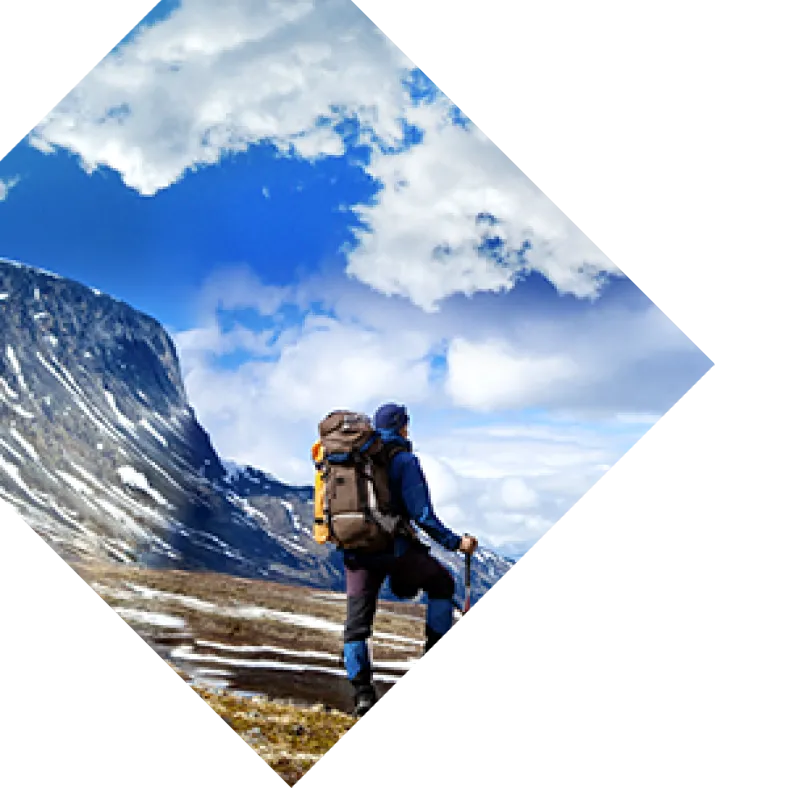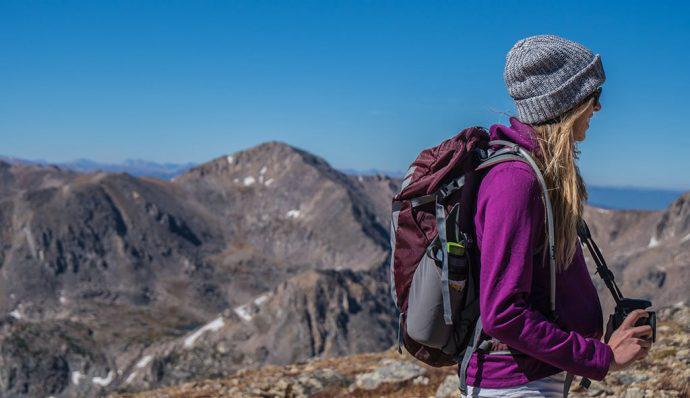 It’s time to leave the stresses of modern life behind and head to the mountains. Or the desert. Or the forest. Or anywhere with a trail. That’s right—it’s time to start hiking. This guide will help you learn the ins and outs of hiking so you can hit the trail with confidence and ease. Nobody has to know you’re new to this.
It’s time to leave the stresses of modern life behind and head to the mountains. Or the desert. Or the forest. Or anywhere with a trail. That’s right—it’s time to start hiking. This guide will help you learn the ins and outs of hiking so you can hit the trail with confidence and ease. Nobody has to know you’re new to this.
Table of Contents
Before You Head Out
Getting started with hiking isn’t hard, especially if you begin with easier trails that are close to home. Nevertheless, hiking always takes at least some knowledge and preparation. To get yourself ready, check out these tips for planning for your first hike—and all the ones to follow.
Choosing a Trail
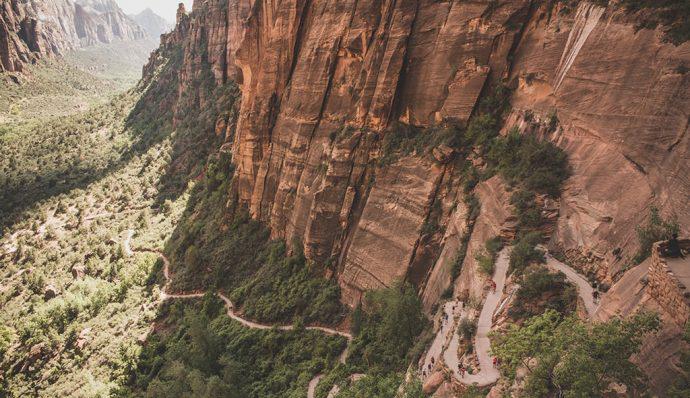
Trail Type
When researching hikes, you’ll often see the “trail type” as a category of information at the top of the page or in a sidebar. Here are definitions of several common trail types:
-
-
- Loop: Start and end at the same place without repeating any part of the trail.
- Out-and-back: Hike to the trail’s end point, and then return the way you came.
- Point-to-point: These trails have more than one access point/trailhead because they are often at least several miles long. If you have the stamina, you can hike to the end and back to where you started. Alternatively, you can get off the trail at another point so you don’t have to repeat any part of the path. Just make sure you’ve arranged a pickup or ride back to your car!
- Lollipop/Semi-loop: Hike out to a loop and then repeat the first part of the path back to the trailhead.
- Interpretive: These are short and easy nature hikes, often with educational signs about the area’s history, wildlife, and flora.
- Spur trail: These short trails branch off from a main trail, and often lead to a scenic viewpoint or a special feature.
-
There are many other types of trails out there, but these are the most common to run into as a beginner.
Difficulty
Hiking a mile is not the same as walking a mile. When hiking, you have to consider several factors including, but not limited to: elevation changes, trail obstacles, length, and seasonal challenges. Research the elevation gain of a trail before you go. Be aware of any injuries you may have (e.g., bad knees) that would make climbs or descents problematic. Don’t merely check the elevation gain over the whole distance of the hike; see how quickly the change happens. An elevation gain of 1,000 feet over a distance of 5 miles isn’t so bad, but that same elevation gain over 1 mile is steep and grueling. If you’re not in top shape, choose trails with minimal elevation gain or gentle switchbacks. Decide what length of trail you’re comfortable with, depending on your fitness level and how long you’d like to be out. The rule of thumb for hiking is to allot 20 minutes per mile for flat, easy terrain. Add in difficult or steep terrain, weather challenges, and time for meals or breaks, and you’re looking at much longer than that baseline. When you’re a beginner, it’s better to choose shorter hikes until you know what you can handle. Find out if there are any trail obstacles along the way (e.g., boulder crossings, mud, fallen trees). You’ll especially want to know if you’ll have to cross any streams without the aid of a bridge. If there is a water obstacle on the trail, refer to the below section called “Crossing a Stream or River” for more information. Depending on where you’re hiking, the season can drastically affect what the landscape is like. Check the trail’s best seasons and if it’s open year-round. Keep in mind that you’ll have less daylight during fall and winter than in the summer. Also, make sure to check the weather forecast before you leave. A little rain is OK, but a huge storm could make the trail dangerous or even inaccessible. Ultimately, choose a trail that inspires you and don’t be intimidated: there are plenty of beautiful trails out there that are doable even for beginners. Just start small and work your way up to longer and more challenging hikes, if that’s what your goal is.
Staying Hike-Healthy
Hiking is a great way to get in better shape, but you should still make sure you (and any hiking buddies) are physically prepared to tackle a trail before you begin. If you haven’t exercised in a while, spend time getting in shape so you can actually enjoy your hike instead of panting at the mere sight of a hill. Take frequent walks around the neighborhood or park, take the stairs, or hit the gym—do whatever it takes to prepare your body for an excursion. Focus on strengthening your muscles, increasing your endurance, and improving your balance and agility. If you need workout ideas, check out our workouts for hiking article. If you’re already in moderate shape, you can start by regularly doing easy hikes and slowly increasing their difficulty. Feeling ready? On the morning of your hike, drink lots of water and don’t skip breakfast. You do not want to get “hangry” on the trail. Ideally, you should eat breakfast two hours before you head out, and fuel yourself with non-sugary carbohydrates; a light breakfast such as whole-wheat toast or whole-grain cereal with low-fat yogurt will help you stay energized. Avoid eating an abundance of saturated fat or protein, as these components digest slowly. Don’t forget to stay hydrated and eat right during and after a hike, too!
Hiking Gear
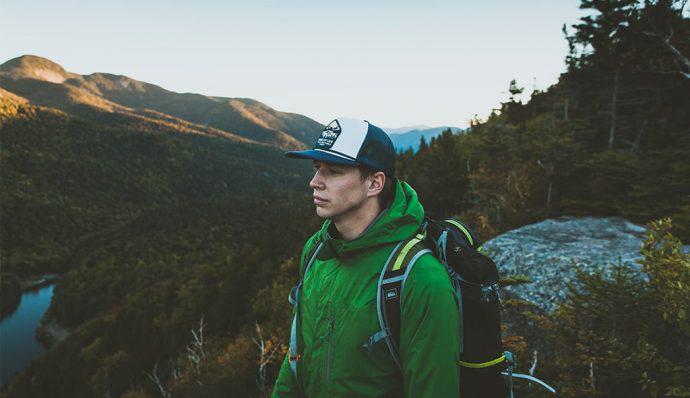 Depending on the trail and the time of year, the gear you’ll need to bring on a hike could vary. However, there are some essential items you should bring on every day hike. This list will get you started:
Depending on the trail and the time of year, the gear you’ll need to bring on a hike could vary. However, there are some essential items you should bring on every day hike. This list will get you started:
-
-
- Select a daypack (a backpack meant for day hiking) that feels comfortable when loaded. Most daypacks have a capacity of 20-35 liters. Choose a bigger pack if you intend to work your way up to longer hikes, or if you plan to go hiking with kids and hold some of their gear.
- If you spring for a new daypack instead of using something you already have, make sure the pack is designed for convenient access to water. It should have an outside pocket meant for holding a water bottle and/or be compatible with a hydration system such as a CamelBak reservoir.
- Invest in quality clothing layers so you can dress according to what the trail and the weather may bring. Layers allow you to regulate temperature and moisture, and can shield you from elements like wind and rain. Refer to our guide on what to wear when hiking for an explanation of how layers work and what you should look for.
- The right footwear can make or break a hike. It can be difficult to find the right hiking shoes or boots, so don’t purchase them on a whim. Take time to research different types of shoes and find your best style and fit. If you decide on boots rather than hiking shoes, we put together a guide on how to choose hiking boots. And don’t forget to break them in!
- Even if you don’t plan on night hiking, it’s good to keep a flashlight or headlamp stashed in your pack just in case.
- Bring a knife or a multi-tool. They are incredibly useful, and you never know when you’ll need one.
- A first-aid kit is an essential on any trail. It should at least be stocked with bandages, antiseptic wipes, pain relief medication, blister treatment, tweezers, and antihistamines (for allergic reactions).
- You never plan on getting lost while hiking, but that’s always a possibility. Stow a map and compass in your daypack, and make sure you know how to use them.
-
For more hiking gear tips, our day hike essentials checklist has you covered. And, you’ve heard it before and you’ll hear it again: make sure to pack plenty of food and water. Bonus tip: This isn’t “gear,” but it’s something else you should bring—cash. Some trails require a day pass that you display on your car’s dashboard or hang from your rear-view mirror. Avoid a parking ticket and research whether your intended trail has a fee. Passes can usually be purchased at the trailhead or national/state park entrance, but it’s often cash-only.
Outdoor Etiquette and Skills
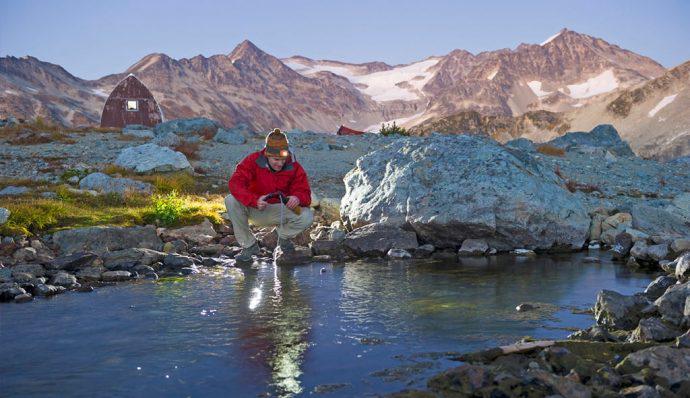 Even as a beginning hiker, there are basic skills to master and unspoken rules to follow. The following tips will help you navigate trails with ease (and avoid irritating fellow hikers).
Even as a beginning hiker, there are basic skills to master and unspoken rules to follow. The following tips will help you navigate trails with ease (and avoid irritating fellow hikers).
Leave No Trace
If you’ve never heard of the Leave No Trace principles, now is a good time to learn. These are guidelines that everybody should follow in the outdoors. Think of them as a code of ethics for minimizing your impact on your natural surroundings. Leave No Trace is about more than simply cleaning up after yourself—it’s about leaving your surroundings as if you were never there at all. As the saying goes, “Take only pictures, leave only footprints.”
Hiking Etiquette
“Be Considerate of Other Visitors” is one of the seven Leave No Trace principles. Here are several tips for good hiking etiquette:
-
-
- Downhill hikers should yield to uphill hikers.
- Stay to the right of the trail on wider paths, and pass other hikers going the same direction on the left. Let them know you are about to pass.
- Hike single-file when with a group.
- If the trail is multi-use, bikers yield to hikers and both yield to horses.
- Keep your voice down so others can enjoy the sounds of nature. (An exception to this guideline is when you’re hiking in an area with bears and need to make noise to avoid surprising one.)
- As much as possible, stay on the trail to reduce erosion. Don’t take shortcuts. However, move off the trail when taking a break, taking care to find a durable surface and not damage plants.
- “Pack it in, pack it out,” is a common hiking phrase. Nobody wants to see your food wrappers on the side of the path, and your trash can harm wildlife. Even biodegradable items such as apple cores and banana peels can take weeks or months to decompose, and are not good for animals, so think twice before tossing them trailside.
- When hiking with a dog, keep your furry friend on a leash and under control. Pack out all waste.
- If you have to use the restroom (when there isn’t one around), head 200 feet off trail and bury solid waste.
- If you bring kids along, make sure to talk with them about trail etiquette as well. This is not only a good idea out of respect for other hikers, but also for your children’s safety.
- Leave what you find. If you see a beautiful flower, fight the urge to pick it. Other hikers will want to see it, too!
-
Hiking etiquette is all about being respectful toward others and the environment. And it never hurts to say hello to your fellow hikers!
Using a Compass and Reading a Map
It’s always possible to get lost or disoriented on hikes, even popular ones. Learning how to use a compass and read a map could save your life. Check out our guides on how to choose a compass, how to use a compass, and how to read a topographic map to introduce you to these skills. What’s a topographic map, you ask? Topographic maps show geographic features and use contour lines to depict changes in the earth’s surface, such as mountains or valleys. Contour lines can even show you how steep a mountainside is. Topographic maps are much different than road maps or simple trail maps, and learning how to read one is an important outdoor skill to have. Some avid hikers choose to invest in a hiking GPS for more complex hikes or backcountry travel. This is a great navigation tool to have, and can give you a lot of information, but don’t depend on it. Technology can fail. Refer to our guide on what to do if you get lost while hiking for more tips on staying on the right track.
Water Purification
Always bring more water on hikes than you think you’ll need. For shorter hikes, that’s an easy rule to follow. But once you start getting into longer and more difficult hikes, you should consider learning how to purify water from streams and lakes. Why? Water is heavy. If there are known water sources along your trail, it could lighten your daypack considerably to filter water found along the way instead of carrying it. Plus, it’s a good survival skill to have. My guide to backpacking for beginners provides more information about purifying water.
Hiking Safety Tips
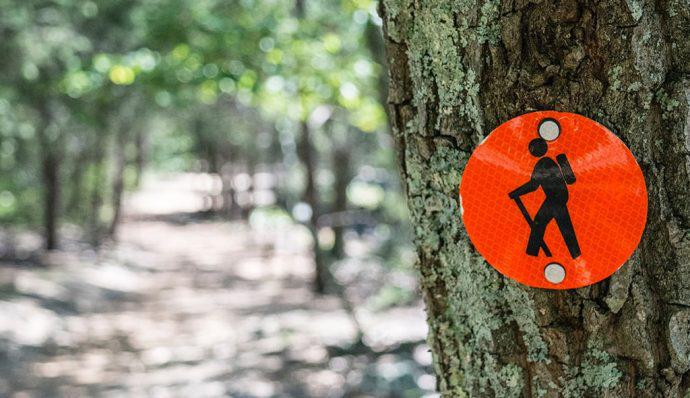 Whether through researching, taking online or in-person wilderness classes, or hiking with experienced outdoorspeople, there are many ways to learn outdoor skills and stay safe on the trail. No matter what, you should always tell friends or family about your hiking plans and what to do if they do not hear from you by a designated time. In case of a serious emergency, you’ll be glad someone is looking out for you. Below are tips for hiking safety. The information is by no means an exhaustive guide, but will help point you in the right direction of what you need to learn or how you can better prepare yourself for staying safe on the trail. For additional tips, check out our article on seven mistakes to avoid while hiking.
Whether through researching, taking online or in-person wilderness classes, or hiking with experienced outdoorspeople, there are many ways to learn outdoor skills and stay safe on the trail. No matter what, you should always tell friends or family about your hiking plans and what to do if they do not hear from you by a designated time. In case of a serious emergency, you’ll be glad someone is looking out for you. Below are tips for hiking safety. The information is by no means an exhaustive guide, but will help point you in the right direction of what you need to learn or how you can better prepare yourself for staying safe on the trail. For additional tips, check out our article on seven mistakes to avoid while hiking.
Hiking in the Snow
Don’t let winter weather deter you from heading outdoors. Hiking in the snow can be a beautiful and refreshing experience. However, winter hiking can pose additional challenges. Here are some tips for hiking in snowy or cold weather:
-
-
- Dress in layers and bring extra layers.
- Avoid cotton, which can quicken the onset of hypothermia once it’s wet.
- Learn how to recognize signs of hypothermia, frostbite, and trench foot.
- Never hike alone in the winter. If possible, find a hiking buddy who is more experienced than you.
- Research the trail before you head out and make sure it’s free of avalanche danger. If an avalanche is possible, learn how to travel in avalanche territory. This is by no means a beginner’s skill.
- It’s much easier to get lost when a fresh blanket of snow obscures the trail, so knowing how to use a compass and topographic map is crucial.
- There are fewer daylight hours in the winter, so make sure you can complete your hike before nightfall. Bring a headlamp or flashlight just in case.
-
With the right preparation, winter hiking can help you beat the cold-weather blues and stay connected with nature.
Hiking in Hot Weather
In some places, summer is the best time of year to hike. But in others, being outdoors in the summer can feel like stepping into an oven. Growing up in the Arizona desert, I know this feeling well. Summer can be brutal, especially when combining high temperatures with physical activity. Complications from hiking in the heat can range from dehydration to heat exhaustion to heat stroke—and even death. If you’re setting out on a hot day, make sure you are prepared to protect yourself from high temperatures and know how to recognize danger signs. This goes beyond drinking water and slapping on sunscreen and a sun hat. The American Hiking Society and the National Park Service offer additional tips for hiking in the heat.
Hiking in the Rain
Hiking in the rain is usually no big deal—if you are prepared. And it’s something you really should prepare for, since rain can happen at any time and during any season. My guide to camping in the rain offers tips on how to dress for wet weather, as does this article on packable rain jackets. Having the right rain gear is essential, and once again, avoid cotton.
Hiking at Night
As a beginner, hiking in the dark is a downright bad idea. However, as you get more skilled in the outdoors, night hiking can be a fun way to experience the same old trail in a new way. Help prepare yourself with do’s and don’ts of night hiking. Bonus tips: Turn off your headlamp every once in awhile to stop and stare at the starry sky. And stay away from trails with dense forest or cliffs.
Crossing a Stream or River
Crossing a river or even an innocent-looking stream can be serious business. There is real danger of injury, hypothermia, or drowning if it goes wrong. Avoid water crossings as a beginning hiker—unless, of course, there is a bridge, or the water is slow and very shallow. Keep in mind that the water level can quickly rise throughout the day due to rain, melting snow, or other environmental factors. As you build up your hiking skills and take on more difficult trails, you should prepare yourself for water crossings. Here are a few resources to acquaint you with the best techniques: River Crossings in the Backcountry, River Safety, and Safety Tips for Fording Streams and Rivers. When you traverse a stream or river, make sure to tackle the challenge with a partner or group—preferably with experienced hikers. If you are not comfortable with it, turn back.
Hiking First Aid
When hiking, don’t just pop a generic first-aid kit in your daypack. Make sure it’s well stocked and specialized to your needs, and you know how to use all of your supplies. You should be prepared to handle a variety of medical situations. Here are some common hiking issues you could encounter, even on an easy hike:
-
-
- Blisters
- Allergic reactions to poisonous plants
- Insect bites or stings
- Cuts
- Sprained ankle
-
Check out our guide to hiking and backpacking first aid for more information on how to build a great first-aid kit.
Additional Resources Mentioned
Below, we've listed the resources mentioned in this guide. Feel free to dive in if you're hungry to learn more. Keep this page bookmarked and because this guide will be updated regularly.
- Ultimate Hiking Workout: 6 Best Training Exercises For Hiking
- What to Eat (And Drink) Before, During, After a Day Hike
- Hiking with Kids: Tips For a Safe and Fun Adventure
- What to Wear When Hiking
- How to Break in Hiking Boots
- 10 Do's and Don'ts of Night Hiking
- How to Build The Best Hiking First Aid Kit
- Wilderness Survival Guide: How to Survive an Unplanned Night in the Woods
- How to Use a Compass
- How to Read a Topographic Map
- Day Hike Essentials Checklist
- Leave No Trace
- Safety Tips For Hiking in Bear Country
- Ultimate Guide: Hiking or Backpacking With Your Dog
- What to Do if You Get Lost Hiking
- Beginner Backpacking Tips: Ultimate Guide For Your First Trip
- 7 Mistakes to Avoid While Hiking
- Your Guide to Winter Hiking
- Camping in the Rain: Tips For Fun in Wet Weather
- Packable Rain Jackets: What You Need To Know
- Safety Tips for Fording Streams and Rivers
Now Get Out and Hike!
Find a trail near you, grab a friend, and go explore the beauty of the outdoors. If you don’t have any outdoorsy friends, search for a hiking group in your area to meet like-minded people. Hikers are generally friendly and welcoming, so don’t be intimidated by joining a group. Don’t get me wrong—hiking can be a solitary activity, too, but sharing the experience is safer and typically more fun. Whether you choose a trail in the city or one far from cell service, hiking is a wonderful way to get some exercise, challenge yourself, connect with nature, and quiet the busy mind. There are so many amazing sights to behold in the wild, and many of them can only be accessed by trail. Adventure awaits!

